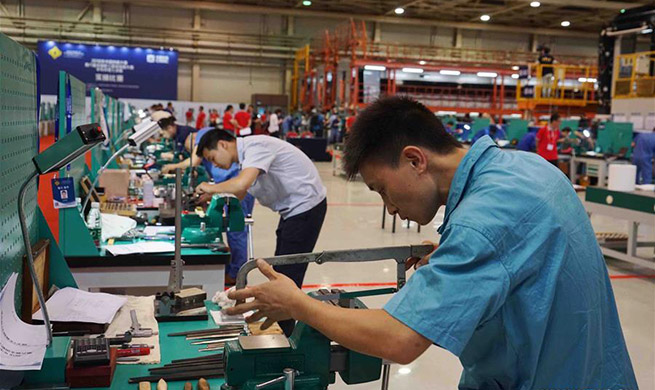By Xinhua writers Peng Peigen, Liu Xinyu, Chen Xu
BEIJING, Aug. 18 (Xinhua) -- With lights flashing and rock music booming, two iron boxers smash, pummel and slash at each other as sparks and robot parts fly in the arena.
The fights are being held on the sidelines of the 2018 World Robot Conference which runs from Wednesday to Saturday. Some 57 teams from across China are competing in the competition.
During each three-minute fight, contestants remotely control their custom-built robots with the aim to paralyze their opponents inside a bullet-proof glass box.
It works much like a boxing competition. Each hit counts as a point and if no knock-out happens, judges count the points and evaluate their offensiveness.
Robot combat shows such as Battlebots in the United States and Robot Wars in Britain were broadcast from as early as 2000, but only in recent years have the events become popular in China.
King of Bots (KOB), a reality show released in January on Zhejiang TV channel, ranked in second for entertainment shows in its time slot on February 26, according to research firm CSM.
KOB also organized the fights during the robot conference in Beijing.
"I watched Battlebots when I was a student, so when I found out China also has robot fight, I immediately decided to take part," said Yang Jie, who teamed up with his 12-year-old son to join the event.
Yang, an engineer who majored in machinery manufacturing and automation, creates robots for the team. His son, who just graduated from elementary school, controls the robots during the fights.
Usually, there are around 20 to 40 teams at a competition, mostly robot fans and university students. The robots compete in different weight classes, from 13.6 kg up to 110 kg.
"A 13.6 kg robot can take a month to make and larger ones can take three months," said Yang, "We choose the materials and do the design by ourselves."
His robot carries a hammer made from a plastic pipe with a metal joint at the tip as its weapon.
The duo has participated in tournaments in several Chinese cities since last year and reached top four in one of the events.
"In the past, there were two to three events per year," said Yang, "Now, there are that many per month."
Lyu Junjie, another contestant, started building fighter robots in 2016.
"Back then, it was just some of my friends building robots and the designs were quite similar," Lyu said, "Now the community has grown to thousands, with many more designs to learn from."
Lyu attributed the growth to publicity, funding, and exchanges due to the emergence of reality TV shows like KOB.
Initially, robot fights were organized as events for university students in related majors to hone their skills and were not open to the public.
"There is a robot culture in many foreign countries, and we want to bring that to China," said Zhang Heng, vice president of The Makers, organizer of KOB.
Zhang's company produced another show called This is Fighting Robot which was broadcast on popular Chinese video site Youku in April. The show invited celebrities to back teams and gained more than 100 million views.
Offline events have also become popular. In the event during the robot conference, hundreds of spectators lined up to watch the fights. Many of them were parents and their children.
"I think my son will enjoy watching robot fights," said Li Wenxiong, waiting in line with his 8-year-old, "It's exciting to watch."
KOB's ambition goes beyond an entertainment show, it has signed top teams in the competition, and plans to run professional matches in Britain, the United States and Australia.
"We see it as a high-tech sport, and we want to run like a sports league in the future," Zhang said.
(Zhang Yinuo and Liu Kexin also contributed to the story)

















